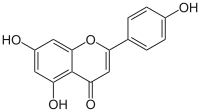アピゲニン
| Apigenin[1] | |
|---|---|

| |
5,7-Dihydroxy-2-(4-hydroxyphenyl)-4H-1-benzopyran-4-one | |
別称 Apigenine; Chamomile; Apigenol; Spigenin; Versulin; 4',5,7-Trihydroxyflavone; C.I. Natural Yellow 1 | |
| 識別情報 | |
| CAS登録番号 | 520-36-5 |
| PubChem | 5280443 |
| ChemSpider | 4444100 |
| DrugBank | DB07352 |
| KEGG | C01477 |
| ChEBI | |
| ChEMBL | CHEMBL28 |
| |
| |
| 特性 | |
| 化学式 | C15H10O5 |
| モル質量 | 270.24 g mol−1 |
| 精密質量 | 270.052823 u |
| 外観 | Yellow crystalline solid |
| 融点 |
345–350 °C |
| 特記なき場合、データは常温 (25 °C)・常圧 (100 kPa) におけるものである。 | |
アピゲニン(Apigenin)は、多くの植物に含まれるフラボンであり、天然に生成する多くの配糖体のアグリコンである。
薬理作用[編集]
近年、アピゲニンはオートファジーと呼ばれる過程を誘導する効果を持つことが明らかとなり、化学的疾病予防剤となる可能性があると同時に化学療法への抵抗を誘導する作用を持つことを説明できるようになった[2]。アピゲニンは、人体中で多くの医薬品の代謝に関わる酵素CYP2C9の阻害剤としても働く[3]。
アピゲニンは、シクロスポリンの副作用を無効にする効果を示す。シクロスポリンAは、ラットの腎臓でトランスフォーミング増殖因子βの発現を促進し、アポトーシスを加速する。そのため、トランスフォーミング増殖因子βとアポトーシス指数は、シクロスポリンAによる腎臓への損傷に対するアピゲニンの効果を評価する指標として使われる[4]。
アピゲニンは、数少ないモノアミントランスポーターの活性化因子の1つとして働く[5]。また、フルニトラゼパムを競合阻害するベンゾジアゼピン受容体のリガンドであり、抗不安薬や精神安定剤としての効果もわずかに示す[6]。
In vitroでは、アピゲニンは赤血球に毒性を持つことが示された[7]。
アピゲニンは、成体の神経発生も活性化させるという研究結果もある。前途有望な成果であるが、ラットを用いた研究で見られた効果は、まだヒトでは実証されていない[8]。
配糖体[編集]
アピゲニンと糖から構成される天然の配糖体には、以下のようなものがある。
- アピイン - パセリ[9]、セロリから単離
- アピゲトリン(アピゲニン-7-グルコシド) - タンポポを使用した代用コーヒーに含まれる
- ビテキシン(アピゲニン-8-C-グルコシド)
- イソビテキシン(アピゲニン-6-C-グルコシド) - ホモビテキシン、サポナレチンとも言う
- ロイフォリン(アピゲニン-7-O-ネオヘスペリドシド)
出典[編集]
- ^ Merck Index, 11th Edition, 763.
- ^ RR Ruela-de-Sousa, GM Fuhler, N Blom, CV Ferreira, H Aoyama, MP Peppelenbosch (2010). “Cytotoxicity of apigenin on leukemia cell lines: implications for prevention and therapy”. Cell Death and Disease 1 (e19): 1–11. doi:10.1038/cddis.2009.18. PMC 3032507. PMID 21364620.
- ^ Si Dayong, Wang Y, Zhou Y-H, Guo Y, Wang J, Zhou H, Li Z-S, Fawcett JP (March 2009). “Mechanism of CYP2C9 inhibition by flavones and flavonols”. Drug Metabolism and Disposition 37 (3): 629–634. doi:10.1124/dmd.108.023416. PMID 19074529.
- ^ Chong FW, Srikumar Chakravarthi, HS Nagaraja, PM Thanikachalam, Nagarajah Lee (2009). “Expression of Transforming Growth factor-β and determination of Apoptotic Index in histopathological sections for assessment of the effects of Apigenin (4',5',7'- trihydroxyflavone) on Cyclosporine A induced renal damage”. Malaysian Journal of Pathology 31 (1): 35–43. PMID 19694312.
- ^ Zhao, G; Qin, GW; Wang, J; Chu, WJ; Guo, LH (2010). “Functional activation of monoamine transporters by luteolin and apigenin isolated from the fruit of Perilla frutescens (L.) Britt”. Neurochemistry international 56 (1): 168–76. doi:10.1016/j.neuint.2009.09.015. PMID 19815045.
- ^ Viola, H; Wasowski, C; Levi De Stein, M; Wolfman, C; Silveira, R; Dajas, F; Medina, JH; Paladini, AC (1995). “Apigenin, a component of Matricaria recutita flowers, is a central benzodiazepine receptors-ligand with anxiolytic effects”. Planta medica 61 (3): 213–6. doi:10.1055/s-2006-958058. PMID 7617761.
- ^ Zbidah, M; Lupescu, A; Jilani, K; Fajol, A; Michael, D; Qadri, SM; Lang, F (2012). “Apigenin-induced suicidal erythrocyte death”. Journal of agricultural and food chemistry 60 (1): 533–8. doi:10.1021/jf204107f. PMID 22132906.
- ^ Taupin, P (2009). “Apigenin and related compounds stimulate adult neurogenesis. Mars, Inc., the Salk Institute for Biological Studies: WO2008147483”. Expert opinion on therapeutic patents 19 (4): 523–7. doi:10.1517/13543770902721279. PMID 19441930.
- ^ }Meyer, Hellen; Bolarinwa, Adrian; Wolfram, Guenther; Linseisen, Jakob (2006). “Bioavailability of Apigenin from Apiin-Rich Parsley in Humans”. Annals of Nutrition and Metabolism 50 (3): 167–72. doi:10.1159/000090736. PMID 16407641.
